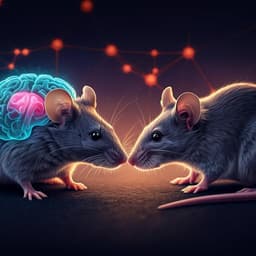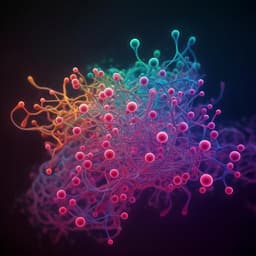
Biology
Dynamic pathogen detection and social feedback shape collective hygiene in ants
B. Casillas-pérez, K. Bodová, et al.
Discover how individual ants make grooming decisions that enhance collective hygiene in their colonies! This study by Barbara Casillas-Pérez, Katarina Bodová, Anna V. Grasse, Gasper Tkacik, and Sylvia Cremer reveals the intricate behaviors that enable ants to efficiently combat fungal pathogens through local interactions.
~3 min • Beginner • English
Introduction
The study investigates how individual decision rules in ants give rise to emergent, colony-level hygiene (social immunity). While social insects exhibit cooperative disease defense through altered interaction networks and sanitary behaviors such as grooming, the quantitative rules guiding who grooms whom and when remain largely unknown. The authors posit that ants make grooming decisions based on locally available, noisy, and dynamically updated information about pathogen presence, and that social feedback from conspecifics modulates these decisions. Understanding these individual rules is important for explaining efficient collective pathogen removal and reduced disease spread at the colony level.
Literature Review
Prior work has established that social insects display self-organized collective behaviors (e.g., transport, foraging, nest choice) and social immunity, including sanitation behaviors that reduce disease risk. Studies show social network plasticity can decrease pathogen transmission, and active grooming removes infectious particles. However, the decision-making algorithms at the individual level and their integration into colony-wide protection are less quantified. The paper builds on literature about feedback-driven collective behavior, epidemiological modeling of social immunity, and exploration–exploitation/speed–accuracy tradeoffs in animal decision-making, to frame how local information and social interactions might shape hygienic grooming decisions.
Methodology
Experimental system: Groups of six Lasius neglectus worker ants (n = 99 groups) were formed; queens were excluded. Two workers per group were treated to create different pathogen-load contrasts: high-dose pathogen, low-dose pathogen, or non-pathogenic control, combined to yield treatments with clear, subtle, or no initial spore-load differences between the two treated individuals. Untreated nestmates (four per group) interacted freely with treated individuals.
Behavioral recording: All individuals were uniquely color-marked; pathogen spores carried distinct genetic fluorescent labels (GFP vs RFP) to track origin. Behavior (self-grooming, allogrooming given/received, poison use from acidopore, and pellet expulsion) was recorded continuously at 5 fps for 30 min pre-treatment and 90 min post-treatment, enabling time-resolved analysis at sub-second resolution and subsequent binning into 30 s windows for summaries.
Pathogen quantification: After 90 min post-treatment, each ant’s head and body were processed separately. Droplet digital PCR (ddPCR) targeting label genes quantified absolute counts of GFP/RFP spores to distinguish (i) spores collected into infrabuccal pockets (head) vs (ii) spores remaining on body surfaces and (iii) spores expelled in pellets (pooled per group; 77 pellet pools). Additional ants (n = 75) frozen immediately after exposure provided distributions of initial applied loads. Quality control included droplet thresholds, background subtraction, and minimum droplet counts.
Spore-load inference: A functional response model (Type II/Michaelis–Menten) for grooming efficiency described spore removal dynamics: high efficiency at high loads with saturation, decreasing at low loads. Fitting this model to terminal spore counts, grooming durations, and pellet data enabled back-inference of each treated ant’s current spore load over time in 30 s windows during the experiment.
Decision-rule modeling: A stochastic state model was built where ants switch among IDLE, SELF, and ALLO (grooming others) states. Using cross-validated model selection, the authors identified key predictors for transitions: perceived pathogen load encountered on others in the recent past (L) and recently received allogrooming (R) as social feedback. The best model combined L and R to predict moment-to-moment grooming activity and target selection. Target-choice rules were contrasted: sequential local rule based on dynamically updated local load estimates; initial-load rule; static treatment-based probabilities; global maximum-load rule; and uniform random.
Knockout and efficiency tests: A functional knock-out experiment constrained nestmates to no-choice scenarios (only one potential target type), compared against matched free-choice scenarios. Stochastic simulations examined the exploration–exploitation tradeoff and efficiency of sequential-choice vs maximum-rule strategies as colony size increases.
Statistics: Mixed models (glmmTMB/lmer), nonparametrics (Wilcoxon, Kruskal–Wallis), correlation (Spearman), regression, Kolmogorov–Smirnov, logistic regression, and bootstrap tests were used, with multiple-comparisons control (Benjamini–Hochberg).
Key Findings
- Pathogen exposure triggered both individual and collective hygiene. Treated ants increased self-grooming and use of antimicrobial poison; untreated nestmates increased caregiving (allogrooming) toward pathogen-treated individuals and also increased self-grooming after grooming infected nestmates.
- Spore processing and removal: Groups with higher initial pathogen loads produced more pellets; the number of spores per pellet did not differ by treatment, suggesting pellets are expelled upon reaching a filling threshold. A Type II functional response captured grooming efficiency: spore reduction rates saturate at high loads and diminish at low loads.
- Dynamic targeting of infective individuals: Using back-inferred current spore loads, nestmates disproportionately groomed the currently higher-load individual rather than based on initial loads. Across grooming decisions (e.g., n ≈ 5001 decisions in groups with two spore-treated individuals; total 8129 decisions by 328 nestmates over 82 replicates), ants showed a significant bias toward higher-current-load targets, and modulated event duration accordingly.
- Social feedback suppresses caregiving: Receiving grooming transiently suppressed an ant’s propensity to perform allogrooming next, with the effect strongest within the first minute and decaying exponentially (half-life on the order of ~30 s). Because higher-load ants receive more grooming, this feedback disproportionately inhibits the most infectious individuals from caregiving.
- Best-fitting decision model: Ant grooming activity was best predicted by a model combining recent perceived pathogen load on others (L) and recently received grooming (R). This L+R model improved moment-to-moment predictability compared to load-only models. Target selection was consistent with a sequential local decision rule using dynamically updated load information rather than initial loads or global knowledge.
- Efficiency and tradeoffs: Stochastic simulations showed that as colony size increases and probing (information acquisition) incurs time costs, the sequential-choice rule (partial/local information) outperforms an idealized maximum rule (complete/global information) in the time required to remove 90% of pathogens, illustrating an exploration–exploitation tradeoff.
- Group-level performance: Experimental groups exhibiting stronger grooming bias toward the higher-load individual achieved higher spore-removal efficiency (more spores in nestmate heads and pellets). In functional knock-out tests, free-choice groups removed more spores than matched no-choice groups (bootstrap, one-sided p = 0.047), indicating that informed individual choices enhance colony-level hygiene.
- Transmission was limited: Although most nestmates became contaminated (≈84–85%) during the assay, spore loads on nestmates were low, consistent with low disease risk and potential for protective immunization in natural contexts.
Discussion
The findings demonstrate that simple, probabilistic individual decision rules—integrating dynamically updated local pathogen-load information and social feedback from recent interactions—are sufficient to generate efficient, colony-level hygiene. By preferentially targeting higher-current-load individuals, ants exploit the higher marginal efficiency of grooming at high pathogen loads (as captured by a Type II response), accelerating removal where it is most effective. Concurrently, social feedback suppresses caregiving by highly infectious individuals (who receive more grooming), reducing their role as potential spreaders and aligning caregiver roles with lower-risk individuals. The identified rules require only short-term memory and local contacts, making them scalable and plausible in large colonies. Simulations link these rules to classic exploration–exploitation and speed–accuracy tradeoffs: when information gathering is costly, localized sequential decisions can outperform optimal global strategies. Collectively, these mechanisms explain how noisy, local decisions culminate in robust social immunity and reduced transmission risk.
Conclusion
This work elucidates the individual decision rules underlying collective hygiene in ants: grooming activity increases with perceived pathogen load on conspecifics, target selection is biased toward currently more infectious individuals, and recent receipt of grooming suppresses one’s own propensity to groom. These simple, locally informed rules synergize to maximize spore removal and minimize spread at the colony level, and they scale favorably due to low information demands. Future research could examine how these rules generalize across species, pathogens, and ecological conditions; dissect sensory modalities and neuromodulatory mechanisms underpinning load estimation and social feedback; and test long-term epidemiological consequences in larger, more natural colonies.
Limitations
- Group size and duration: Experiments used small groups of six workers and short observation windows (90 min post-treatment), which may not capture dynamics in full-sized colonies or over longer timescales.
- Caste and life stage: Only worker ants were studied; queens and brood dynamics were not included and may exhibit different behaviors.
- Laboratory constraints: Controlled lab settings and specific exposure protocols may differ from natural environmental variability and contact structures.
- Modeling assumptions: Spore-load inference relies on fitted functional-response models and behavioral annotations; deviations from model assumptions or measurement noise could affect estimates of current load and inferred decision rules.
- Pathogen/context specificity: Results were obtained with a specific entomopathogenic fungus and assay conditions; generality across pathogens and contexts requires further testing.
Related Publications
Explore these studies to deepen your understanding of the subject.







